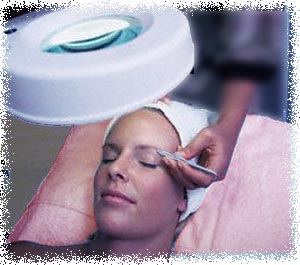Cosmetic Laser Surgery

Since the 1960s, lasers have been used to treat skin lesions. When acne scars were being treated with a laser, it was noticed that the small wrinkles close to the treated area were greatly reduced. Getting rid of wrinkles and face lines, acne scars, folds and creases on the face and even hair removal - all this can be done with laser surgery. These days cosmetic laser surgery is being used to treat skin blemishes, birthmarks and tumors. Other skin changes such as uneven or dull skin tone can also be treated. Lasers are being increasingly used in surgery since they can cut through tissue sans excessive bleeding that is associated with traditional scalpel surgery. Different types of laser are used in cosmetic laser surgery.
Carbon dioxide lasers are popularly used for dermatological applications, especially facial resurfacing and growth removal. Collagen - the fibrous protein in the skin gives it the texture. This collagen layer is destroyed over time with sun exposure and age. With cosmetic laser surgery, new collagen is formed. This gives the skin a new youthful appearance. We examine laser resurfacing of the skin - a cosmetic laser procedure that rids the skin of small wrinkles and fine lines.
Laser resurfacing
Laser resurfacing involves vaporizing superficial layers of facial skin. This allows a new layer of skin to be formed over a fresh surface. The laser resurfacing procedure can be carried out in an operating room or hospital. It can last from a few minutes to a few hours, depending on the extent of treatment and the size of the area being treated. An intense pulsating beam of light is used to heat the underlying skin so as to stimulate new collagen fibers to grow. Surgeons can guide the laser beams to specific type of tissues that need to be treated. The new skin that appears on the wound is smoother and tighter. Specific areas can be treated with cosmetic lasers.
Superficial laser resurfacing is done by limiting the laser to the epidermis and papillary dermis. The upper levels of the reticulas dermis can be removed for a deeper resurfacing. The skin appears pink and thinly crusted soon after this cosmetic procedure. There may be a mild burning sensation. It is essential to keep the skin moist with creams and covered with a bandage. It takes about two weeks for the skin to heal completely. Reducing sun exposure and liberal use of sunscreen is recommended. Sun blocks with SPF of 15 or higher must be applied.
Laser resurfacing is generally performed under local anesthesia when treating localized areas on the face. But more extensive cosmetic laser surgery necessitates general anesthesia. The activated laser is passed back and forth on the skin till the wrinkle or scar is reduced. The treated area is layered with protective creams and sometimes bandaged. Any mild swelling is controlled with ice packs and suitable medications. The bandages may need to be replaced every couple of days till healing is complete. It is important not to pick the crusts from the treated area so as to prevent scarring. Makeup should be avoided till healing is complete.
Laser resurfacing procedure
Laser energy is delivered in short pulses so as to vaporize only the top layer of the skin. Each laser pulse is less than a millisecond. The skin is wiped with water between each laser pulse so as to cool it. The skin is also wiped to remove the destroyed tissue. This is continuously done till the desired result is achieved. A slight burning sensation is felt. The surgeon needs to control the intensity of the light and move it over the areas that are to be treated.
The heat generated during the process tends to shorten the collagen fibers in the skin and leads to improved elasticity. Here, the doctor has more control over the penetration into the skin vis-à-vis other treatments such as chemical peels and dermabrasion. Full face resurfacing is seen as an alternative to surgical facelifts. Patients are usually advised to use glycolic acid or Retin-A for a few weeks prior to laser cosmetic resurfacing.
Cosmetic laser surgery is preferred for its non-invasive technique and superior therapeutic results. Laser resurfacing is done with a Carbon dioxide laser that can be carried out on the whole face or specific areas. Lesser bleeding, bruising and post-operative discomfort is noticed with this revolutionary new cosmetic laser surgery method. Possible side effects of laser resurfacing are burn injuries due to laser heat energy and scarring.
Laser resurfacing is not advisable for persons with very delicate or sensitive skin. Darker skin tones do not benefit dramatically from this laser cosmetic procedure. Some people experience hypopigmentation on the area that was treated with cosmetic laser. Persons with olive, brown or black skin may be at increased risk for pigmentation changes. Patients suffering from herpes simplex may notice facial pain and fever immediately after the laser resurfacing procedure.
Carbon dioxide lasers are the most powerful ones that are used to reduce deep wrinkles. Erbium:YAG lasers are comparatively milder and target tissues with more accuracy than carbon dioxide lasers. The time taken for recovery from Er:YAG laser treatment is lesser. A new type of laser combining the above types of lasers is being popularly used. The Er:YAG laser removes the epidermal layer and the carbon dioxide laser contracts the collagen to tighten the skin. There are many unqualified cosmetic surgery practitioners who are not sufficiently trained to carry out this procedure. It is essential to choose a good plastic surgeon to work on your cosmetic laser surgery.
Top of the Page: Cosmetic Laser Surgery
Tags:#cosmetic Laser surgery #laser resurfacing
 Beauty
Beauty Cosmetic Surgery
Face
Cheek Implants
Mini Facelift
Non Surgical Face Lift
Eyebrow Transplantation
Cosmetic Eye Surgery
Ear Plastic Surgery
Rhinoplasty
Chin Liposuction
Cosmetic Dentistry
Facial Cosmetic Surgery
Chin Surgery
Reconstructive Facial Surgery
Body
Sublative Rejuvenation
Lower Body Lift
Anti-ageing Cosmetics
Wart Removal
Mole Removal
Breast Augmentation
Liposuction
Liposuction Surgery
Cosmetic Laser Surgery
Spider Vein Laser Surgery
Abdominal Liposuction
Umbilicoplasty Surgery
Plasma Skin Resurfacing
Skin Tag Removal
Top of the Page: Cosmetic Laser Surgery
Popularity Index: 100,741

